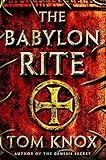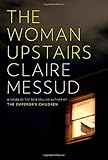 Walter Benjamin would have loved this guy Tom Knox. In our age of mechanical reproduction, for starters, Tom Knox is an immaculate work of artifice. He keeps cranking out books even though he doesn’t exist. Tom Knox, you see, is the pen name for Sean Thomas, a peripatetic British novelist, journalist, blogger, and travel writer. What’s more, The Babylon Rite, the fourth novel by “Tom Knox,” works overtime to live up to Benjamin’s dictum that all great works of literature must either dissolve a genre or invent one.
Walter Benjamin would have loved this guy Tom Knox. In our age of mechanical reproduction, for starters, Tom Knox is an immaculate work of artifice. He keeps cranking out books even though he doesn’t exist. Tom Knox, you see, is the pen name for Sean Thomas, a peripatetic British novelist, journalist, blogger, and travel writer. What’s more, The Babylon Rite, the fourth novel by “Tom Knox,” works overtime to live up to Benjamin’s dictum that all great works of literature must either dissolve a genre or invent one.
Actually, The Babylon Rite doesn’t just dissolve a genre. It pours half a dozen genres into a literary Waring blender, hits the puree button, and serves up something that can only be called the first archaeological Knights Templar Meso-American whodunit Dan-Brown-send-up international drug-cartel Mafia splatter-fest of a cult thriller.
There’s hair on the walls of this novel, to quote one of the killers in Truman Capote’s genre-dissolving “non-fiction novel,” In Cold Blood, which may be the ur-text of the trend Walter Benjamin yearned for back in the 1930s. In fact, there’s so much blood gurgling through the pages of The Babylon Rite that it seems almost beside the point to say that the novel is a three-headed beast. Three groups – a journalist and a grieving woman in England; a team of archaeologists in Peru; and a pair of overworked London homicide cops – are all trying to unlock the secret ceremony of the medieval Knights Templar, the so-called Babylon Rite, that turned them into crazed, fearsome warriors and now, apparently, is causing corpses to pile up on two continents. Since the beating heart of this novel is the ingenious ways Tom Knox kills off his darlings, maybe the best way to understand this new genre is simply to catalog the slaughter. Here, then, is the coroner’s report, including victims and means of dispatch:
1. Museum curator, killed by truckful of gasoline ramming into a gas station that sits over a secret underground archaeological museum. Apparent murder.
2. World’s foremost authority on the Knights Templar, killed by driving his car into a brick wall at high speed. Apparent suicide, possible murder.
3. Russian ambassador’s nephew, killed by severing his own feet and one hand, then trying to cut off his own head, all with a very expensive kitchen knife. Apparent suicide, assisted by gay porn videos and, possibly, drugs.
4. Heir to a German fortune, killed by self-decapitation with chainsaw. Stone cold suicide, no doubt about this one.
5. Journalist’s lover, killed when crushed by a car while riding her bicycle at night in Australia under the influence of alcohol. Apparent accidental homicide.
6. London party girl, dies after slicing off her own lips, nostrils, earlobes and cheeks. Apparent suicide.
7. American archaeologist in Peru, shot twice outside a tomb of the pre-Colombian Moche civilization. Murder, possibly by members of a Mexican drug cartel.
8. Daughter of world’s foremost authority on the Knights Templar, dies after slitting her own throat during drug-induced sexual frenzy. Apparent multi-orgasmic suicide.
9. Murderous Italian mafioso, shot by police sharpshooter. Justifiable homicide.
10. London homicide cop garrotted during stake-out. Murder, no known suspect.
11. One Amazon riverboat captain and one deck hand, decapitated by drug cartel bad guys. Double homicide.
12. Amazon guide, killed when a drug cartel leader slices open his thigh and inserts a carnivorous “vampire fish” in the wound, which proceeds to devour the hapless Amazon guide from the inside. Murder.
13. Mexican drug cartel boss killed when his intended rape victim slits his throat with a razor blade concealed in her mouth. Justifiable homicide, self-defense.
14. Cartel bodyguard, killed by single gunshot. Homicide, but nobody will miss this dirtbag.
15. Zeta cartel thug, shot by a journalist. Justifiable homicide, leaving artsy spray of blood and innards on wall.
16. Archaeologist heroine, killed by self-inflicted throat slashing. Drug-induced suicide, partly explained because she realizes she is suffering from terminal Huntington’s Disease.
So there you have it, well over a dozen dead bodies killed by the whole arsenal – explosives, kitchen knife, chainsaw, gun, motor vehicle, piano wire, straight razor, hit-and-run, machete, and intestine-eating fish. If this book were a movie, it’d be a shoo-in for the Joe Bob Briggs Drive-In Hall of Fame.
For all this rococo violence, though, the prose is generally pedestrian and frequently downright laughable. Here’s Dan, the head of the team of archaeologists examining pre-Colombian ceramics in Peru, in conversation with his lover/understudy Jessica:
(Dan) gazed right back at her. “Of course, if your theory is in any way correct it means virtually all the erotic practices of the ceramicas, the cermicas eroticas, must depict sexual acts the Moche actually performed. Rather incredible, no?”
“Not incredible. That’s my perception. They did it.”
“Sex with animals?” Dan was half-laughing, yet his expression was sickened. “Women masturbating dying men, men who had been half-flayed?
Sex with skeletons, foreplay with mutilated corpses? Christ.”
“Bestiality and necrophilia, in fervent variety. Yep, I reckon that’s what they did.”
Yep, I reckon that’s what they did – coming after such a litany of kinky death, that sentence is all the proof you need that “Tom Knox” has ears made of pure tin. I thought it was impossible to top that line, but I thought wrong. Here’s the Aussie journalist Adam, zonked on a sex- and violence-inducing drug, gunning down a Mexican drug cartel thug, (killing #15 from the above list):
The urge was orgasmic. And irresistible. Adam lifted the gun, and he fired, exultantly. He had never shot a gun in his life: but this was so good. The bullet slammed the man to the wall, silhouetting him with a corona of his own blood, another Jackson Pollock on the wall, the abstract expressionism of death.
This writing is so bad. But people don’t read books like this for the lambent and lyrical prose found in most literary fiction about emperors or maladies or the incredible lightness of splendid suns; people read such books for the storytelling, period. And while it’s often possible to hear the gears of the plot groaning, there’s no denying that the pages fly by as The Babylon Rite races toward its drug-fueled, hyperventilated blood bath of a climax. That, in all fairness, is not nothing.
 There has been a lot of giddy talk lately about the crumbling of the walls that once divided literary genres into tidy fiefs. In our brave and blurry new world, categories matter far less than the quality of the writing. Cross-pollination is king. Elmore Leonard’s crime novels have drawn raves from highbrows, including Walker Percy. To the delight of many readers, myself included, writers as diverse as Patricia Highsmith, Neal Stephenson, China Miéville, William Gibson, John le Carré, and Philip K. Dick have busted out of the ghettos of their various genres and attracted readers who once steered clear of literature’s shadowy precincts. As Emily St. John Mandel put it here recently, “Le Carré is worth reading whether you like genre fiction or not.” The literary novelist Kate Atkinson is now rubbing shoulders on the bestseller lists with that prolific corporation known as James Patterson, with no apparent discomfort to either party. Claire Messud’s new novel, The Woman Upstairs, is literary fiction that owes a large debt to such psychological horror films as The Hand That Rocks the Cradle. Everything is fair game for the novelist today – horror, thrillers, porn, fairy tales, pulp, splatter, comics, text messages, vampires, computer games, e-mail, tabloid headlines, sit-coms, spies, zombies, and, yes, such conventionally lofty sources as Shakespeare and Jane Austen and the Bible. And readers are richer for it.
There has been a lot of giddy talk lately about the crumbling of the walls that once divided literary genres into tidy fiefs. In our brave and blurry new world, categories matter far less than the quality of the writing. Cross-pollination is king. Elmore Leonard’s crime novels have drawn raves from highbrows, including Walker Percy. To the delight of many readers, myself included, writers as diverse as Patricia Highsmith, Neal Stephenson, China Miéville, William Gibson, John le Carré, and Philip K. Dick have busted out of the ghettos of their various genres and attracted readers who once steered clear of literature’s shadowy precincts. As Emily St. John Mandel put it here recently, “Le Carré is worth reading whether you like genre fiction or not.” The literary novelist Kate Atkinson is now rubbing shoulders on the bestseller lists with that prolific corporation known as James Patterson, with no apparent discomfort to either party. Claire Messud’s new novel, The Woman Upstairs, is literary fiction that owes a large debt to such psychological horror films as The Hand That Rocks the Cradle. Everything is fair game for the novelist today – horror, thrillers, porn, fairy tales, pulp, splatter, comics, text messages, vampires, computer games, e-mail, tabloid headlines, sit-coms, spies, zombies, and, yes, such conventionally lofty sources as Shakespeare and Jane Austen and the Bible. And readers are richer for it.
 It turns out that Capote’s “non-fiction novel” did more than blend two forms. It stretched the way we categorize and think about books, inspiring other hybrids that would have once seemed oxymoronic, even sacrilegious, but are now perfectly acceptable. One such book is The Roadmap by the former Burmese political prisoner Ma Thida (writing under the pseudonym Suragamika), which bills itself as “documentary fiction.” In a very real sense, In Cold Blood made The Roadmap possible.
It turns out that Capote’s “non-fiction novel” did more than blend two forms. It stretched the way we categorize and think about books, inspiring other hybrids that would have once seemed oxymoronic, even sacrilegious, but are now perfectly acceptable. One such book is The Roadmap by the former Burmese political prisoner Ma Thida (writing under the pseudonym Suragamika), which bills itself as “documentary fiction.” In a very real sense, In Cold Blood made The Roadmap possible.
In addition to genre-dissolvers, -creators, and -blenders, there is also a new crop of genre-jumpers. John Banville writes literary fiction with his right hand, then shifts gears and writes noirish crime novels, as Benjamin Black, with his left. Banville has called Black “my dark twin and brother.” The two appear to get along famously.
Which doesn’t mean that all writers who mix, dissolve or create genres automatically produce great literature. Sometimes, quite the opposite. Bad writing is still bad writing, no matter what the label says. With The Babylon Rite, Tom Knox has proved this beyond any doubt. Yep, that’s what he did.








